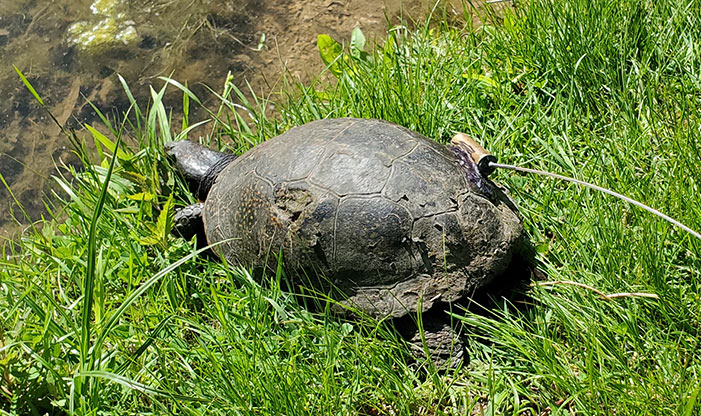Earlier this month, thanks in part to a grant from the Wisconsin Citizen-based Monitoring Network and the keen eye of a local news videographer, Schlitz Audubon commenced a long-planned turtle monitoring initiative.
Turtle Species at the Center
Schlitz Audubon staff and volunteers routinely conduct basking surveys in the Center’s six permanent ponds to determine turtle populations. Painted turtles are by far the most common species sighted and are found in all of the ponds. Snapping turtles can routinely be seen in Mystery Lake and Pond. Blanding’s turtles are the most elusive of all species at the Center, and have mostly been sighted near Research Pond. Blanding’s turtle is a rare species in Wisconsin, carrying the state status of Special Concern, meaning that they are a protected wild animal.
Last year, we applied for and received a grant from the Wisconsin Citizen-based Monitoring Network to procure telemetry equipment to help monitor and track the on-site population of Blanding’s turtles, as well as to work with students in traditionally underserved populations to introduce them to our turtle monitoring efforts.
Rediscovering a Blanding’s Turtle
Despite our great intentions, our efforts did not go as planned. No Blanding’s turtles were spotted in the summer of 2019, and COVID-19 forced us to cancel the spring field trips during which we planned to conduct basking surveys with students. Our team was elated, then, on the morning of June 4, when a FOX6 videographer shooting news segments at the Center noticed a very large turtle crossing a trail near Mystery Lake. A Blanding’s turtle had been spotted once again!
Tracking Habitat Use
Within days, the turtle was relocated and a radio transmitter was affixed to its shell. The transmitter is a copper tube about two inches long, with a wire coming off the end that transmits pulsed radio signals. With a special antenna, these signals can be received and triangulated to calculate the turtle’s location.
Schlitz Audubon’s conservation team follows Wisconsin Department of Natural Resources (WDNR) best management practices to ensure the safety of the Blanding’s turtles on site. However, little is known about their habitat use. With the transmitter in place, we can study how and when Blanding’s turtles are utilizing the landscape. This is critical information that will guide our team in protecting and enhancing turtle habitat during site restoration and reforestation projects. Furthermore, this information will be shared with the conservation community and as an exciting real-life example in future educational programming.
The Community’s Role Protecting Turtles
The WDNR encourages citizens to help monitor and protect all turtle species. Through their Wisconsin Turtle Conservation Program, the WDNR aims to better catalog species’ statewide distributions and to document high turtle mortality locations. You can participate this program to help manage and conserve Wisconsin’s turtles – every sighting helps!
Citizen science volunteers are critical to or conservation work, help us catalog data about the land, as well as the plants and animals who live here throughout the year or during migration. Though most of our summer 2020 activities were curtailed, we normally run 20 Citizen Science projects per year.


